Individual Reflection: ICT's Influence on the Tourism Industry
VerifiedAdded on 2021/01/03
|7
|1924
|318
Report
AI Summary
This report provides an individual reflection on the impact of Information Communication Technology (ICT) on the tourism industry. It begins with an introduction to ICT and its historical development, highlighting its role in enhancing communication and business operations. The reflection then delves into the application of Schumpeter's theory of technological evolution and the theory of innovation diffusion to explain ICT's growth within the tourism sector. The report analyzes the influence of ICT on various aspects of tourism, including online reservations, customer relations, supply chain management, and the role of travel agents. Porter's Five Forces are used to critically evaluate technical innovation within the industry. Furthermore, it explores the impact of ICT on tourism competitiveness, economic growth, and the changing landscape of customer interactions. Various models and strategies, such as Porter's Generic Strategies, Treacy and Wiersema model, and BCG matrix, are used to assess competitive advantages and business efficiencies within the tourism sector. The report concludes by emphasizing how ICT has revolutionized the tourism sector and its implications for tourism development globally.
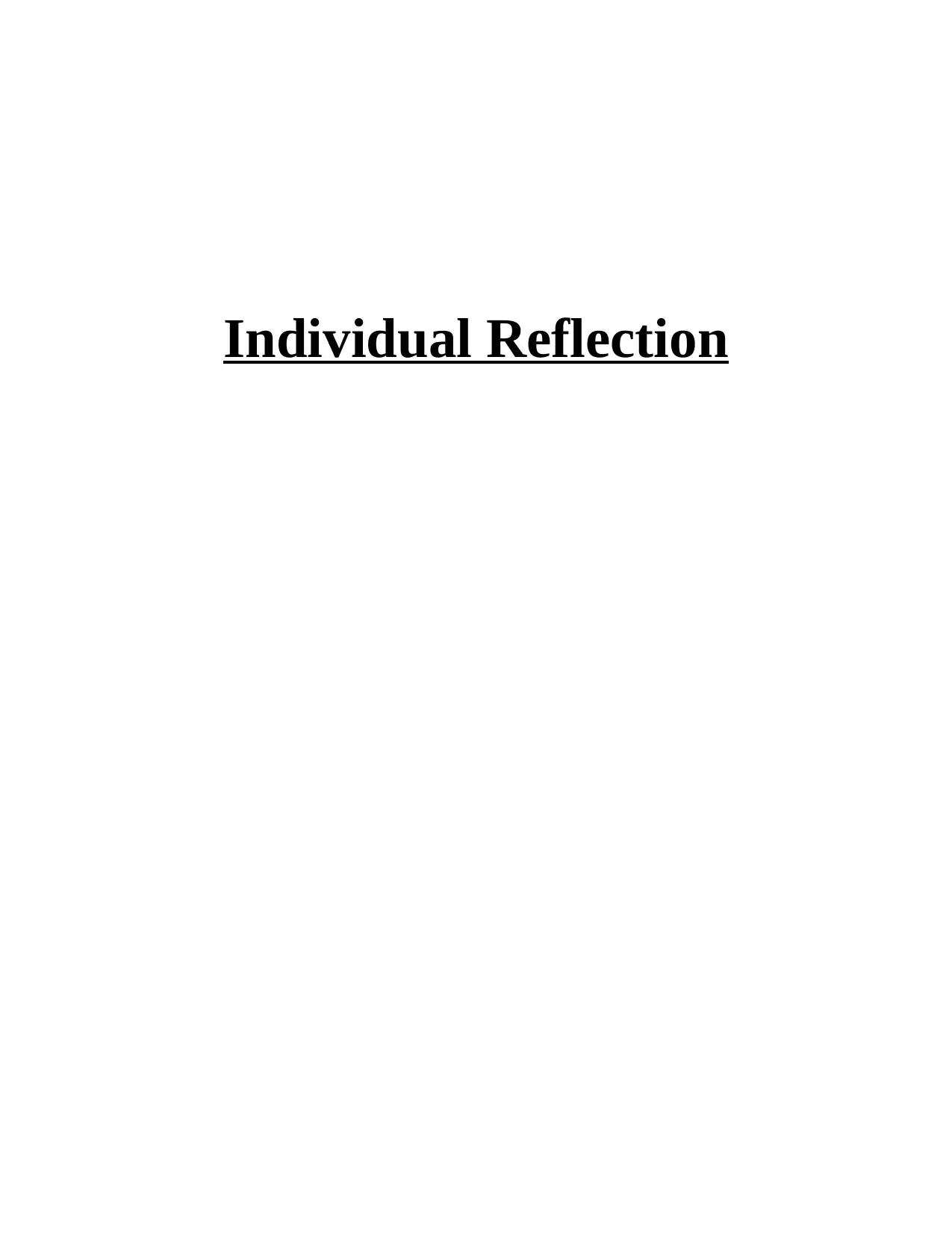
Individual Reflection
Paraphrase This Document
Need a fresh take? Get an instant paraphrase of this document with our AI Paraphraser
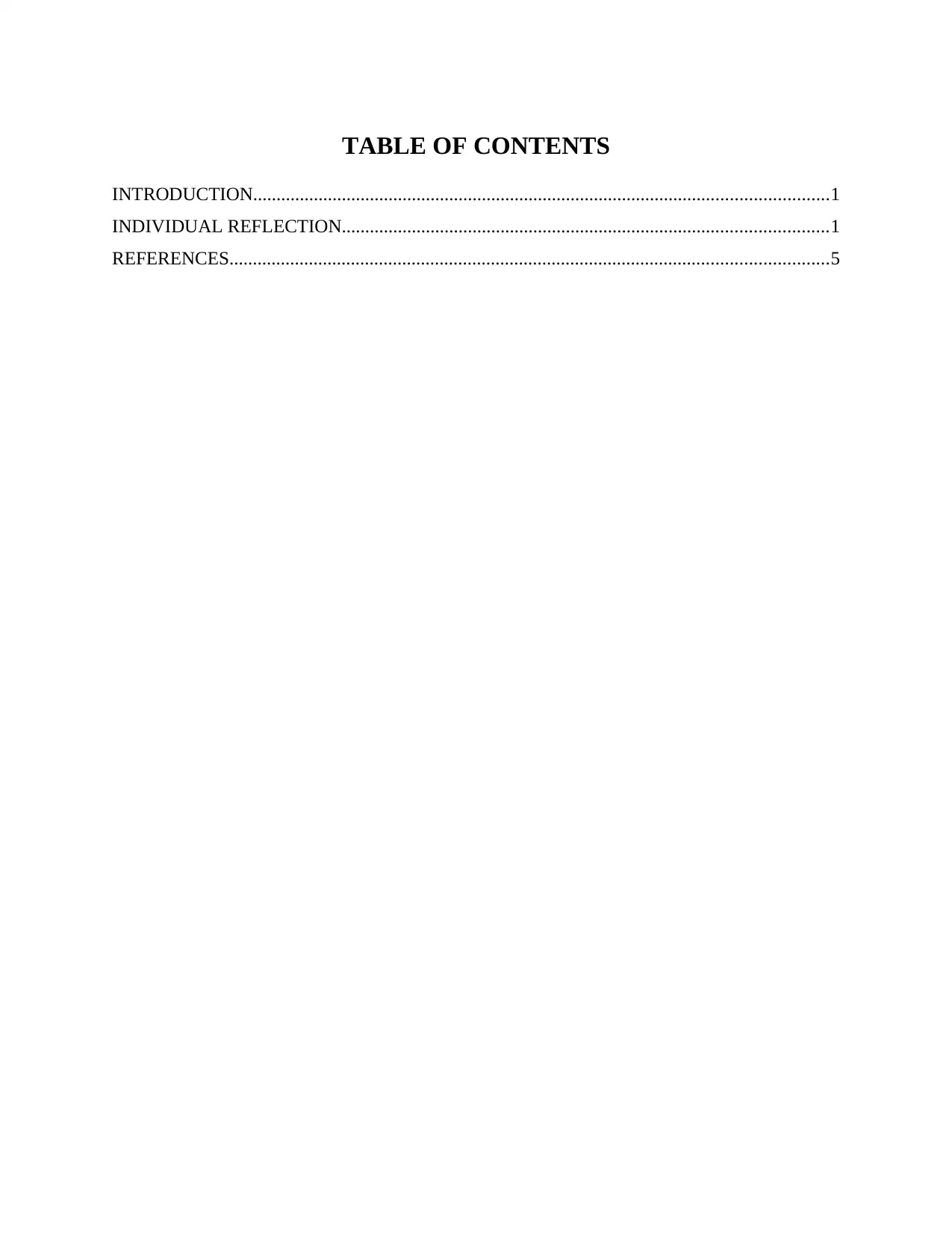
TABLE OF CONTENTS
INTRODUCTION...........................................................................................................................1
INDIVIDUAL REFLECTION........................................................................................................1
REFERENCES................................................................................................................................5
INTRODUCTION...........................................................................................................................1
INDIVIDUAL REFLECTION........................................................................................................1
REFERENCES................................................................................................................................5
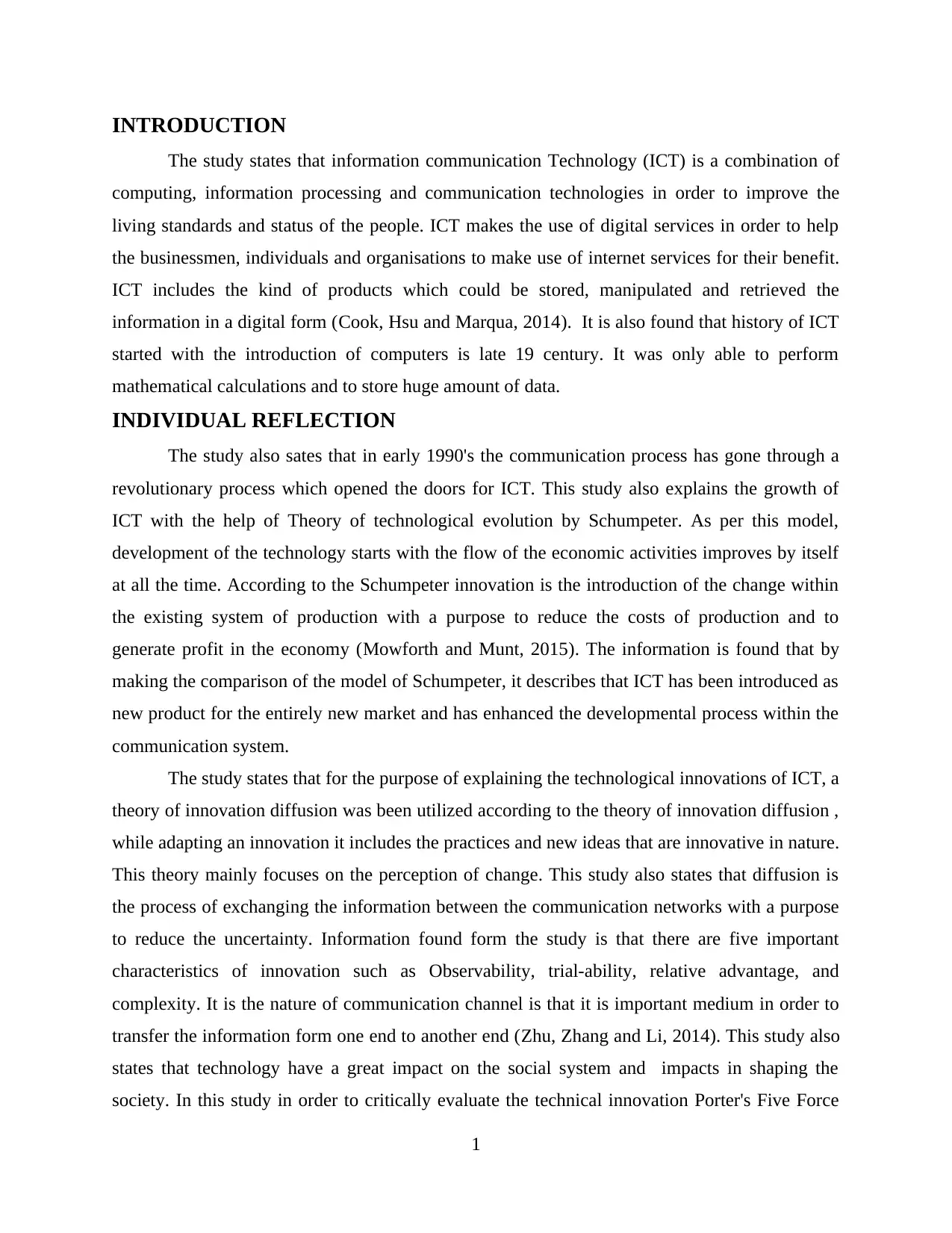
INTRODUCTION
The study states that information communication Technology (ICT) is a combination of
computing, information processing and communication technologies in order to improve the
living standards and status of the people. ICT makes the use of digital services in order to help
the businessmen, individuals and organisations to make use of internet services for their benefit.
ICT includes the kind of products which could be stored, manipulated and retrieved the
information in a digital form (Cook, Hsu and Marqua, 2014). It is also found that history of ICT
started with the introduction of computers is late 19 century. It was only able to perform
mathematical calculations and to store huge amount of data.
INDIVIDUAL REFLECTION
The study also sates that in early 1990's the communication process has gone through a
revolutionary process which opened the doors for ICT. This study also explains the growth of
ICT with the help of Theory of technological evolution by Schumpeter. As per this model,
development of the technology starts with the flow of the economic activities improves by itself
at all the time. According to the Schumpeter innovation is the introduction of the change within
the existing system of production with a purpose to reduce the costs of production and to
generate profit in the economy (Mowforth and Munt, 2015). The information is found that by
making the comparison of the model of Schumpeter, it describes that ICT has been introduced as
new product for the entirely new market and has enhanced the developmental process within the
communication system.
The study states that for the purpose of explaining the technological innovations of ICT, a
theory of innovation diffusion was been utilized according to the theory of innovation diffusion ,
while adapting an innovation it includes the practices and new ideas that are innovative in nature.
This theory mainly focuses on the perception of change. This study also states that diffusion is
the process of exchanging the information between the communication networks with a purpose
to reduce the uncertainty. Information found form the study is that there are five important
characteristics of innovation such as Observability, trial-ability, relative advantage, and
complexity. It is the nature of communication channel is that it is important medium in order to
transfer the information form one end to another end (Zhu, Zhang and Li, 2014). This study also
states that technology have a great impact on the social system and impacts in shaping the
society. In this study in order to critically evaluate the technical innovation Porter's Five Force
1
The study states that information communication Technology (ICT) is a combination of
computing, information processing and communication technologies in order to improve the
living standards and status of the people. ICT makes the use of digital services in order to help
the businessmen, individuals and organisations to make use of internet services for their benefit.
ICT includes the kind of products which could be stored, manipulated and retrieved the
information in a digital form (Cook, Hsu and Marqua, 2014). It is also found that history of ICT
started with the introduction of computers is late 19 century. It was only able to perform
mathematical calculations and to store huge amount of data.
INDIVIDUAL REFLECTION
The study also sates that in early 1990's the communication process has gone through a
revolutionary process which opened the doors for ICT. This study also explains the growth of
ICT with the help of Theory of technological evolution by Schumpeter. As per this model,
development of the technology starts with the flow of the economic activities improves by itself
at all the time. According to the Schumpeter innovation is the introduction of the change within
the existing system of production with a purpose to reduce the costs of production and to
generate profit in the economy (Mowforth and Munt, 2015). The information is found that by
making the comparison of the model of Schumpeter, it describes that ICT has been introduced as
new product for the entirely new market and has enhanced the developmental process within the
communication system.
The study states that for the purpose of explaining the technological innovations of ICT, a
theory of innovation diffusion was been utilized according to the theory of innovation diffusion ,
while adapting an innovation it includes the practices and new ideas that are innovative in nature.
This theory mainly focuses on the perception of change. This study also states that diffusion is
the process of exchanging the information between the communication networks with a purpose
to reduce the uncertainty. Information found form the study is that there are five important
characteristics of innovation such as Observability, trial-ability, relative advantage, and
complexity. It is the nature of communication channel is that it is important medium in order to
transfer the information form one end to another end (Zhu, Zhang and Li, 2014). This study also
states that technology have a great impact on the social system and impacts in shaping the
society. In this study in order to critically evaluate the technical innovation Porter's Five Force
1
⊘ This is a preview!⊘
Do you want full access?
Subscribe today to unlock all pages.

Trusted by 1+ million students worldwide
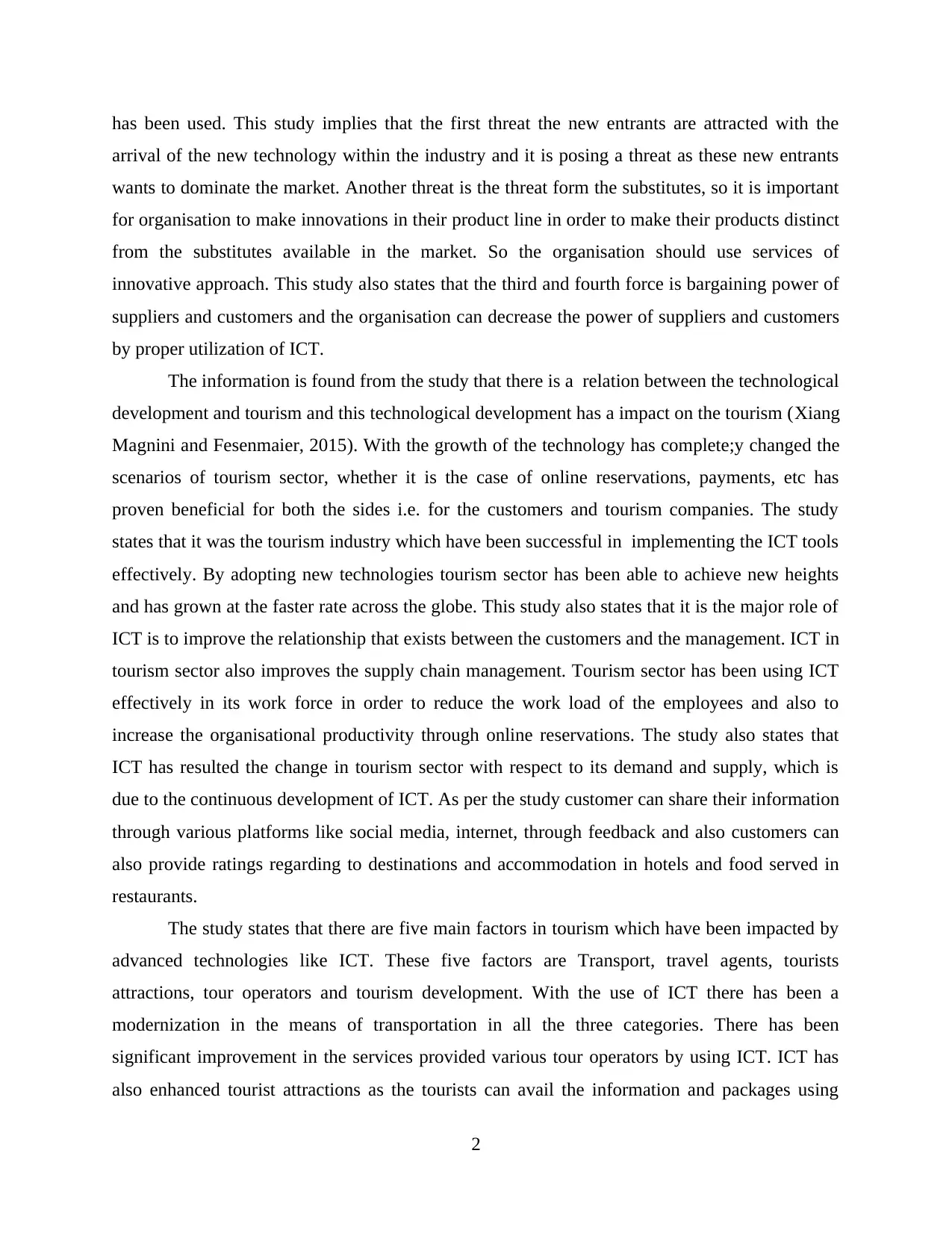
has been used. This study implies that the first threat the new entrants are attracted with the
arrival of the new technology within the industry and it is posing a threat as these new entrants
wants to dominate the market. Another threat is the threat form the substitutes, so it is important
for organisation to make innovations in their product line in order to make their products distinct
from the substitutes available in the market. So the organisation should use services of
innovative approach. This study also states that the third and fourth force is bargaining power of
suppliers and customers and the organisation can decrease the power of suppliers and customers
by proper utilization of ICT.
The information is found from the study that there is a relation between the technological
development and tourism and this technological development has a impact on the tourism (Xiang
Magnini and Fesenmaier, 2015). With the growth of the technology has complete;y changed the
scenarios of tourism sector, whether it is the case of online reservations, payments, etc has
proven beneficial for both the sides i.e. for the customers and tourism companies. The study
states that it was the tourism industry which have been successful in implementing the ICT tools
effectively. By adopting new technologies tourism sector has been able to achieve new heights
and has grown at the faster rate across the globe. This study also states that it is the major role of
ICT is to improve the relationship that exists between the customers and the management. ICT in
tourism sector also improves the supply chain management. Tourism sector has been using ICT
effectively in its work force in order to reduce the work load of the employees and also to
increase the organisational productivity through online reservations. The study also states that
ICT has resulted the change in tourism sector with respect to its demand and supply, which is
due to the continuous development of ICT. As per the study customer can share their information
through various platforms like social media, internet, through feedback and also customers can
also provide ratings regarding to destinations and accommodation in hotels and food served in
restaurants.
The study states that there are five main factors in tourism which have been impacted by
advanced technologies like ICT. These five factors are Transport, travel agents, tourists
attractions, tour operators and tourism development. With the use of ICT there has been a
modernization in the means of transportation in all the three categories. There has been
significant improvement in the services provided various tour operators by using ICT. ICT has
also enhanced tourist attractions as the tourists can avail the information and packages using
2
arrival of the new technology within the industry and it is posing a threat as these new entrants
wants to dominate the market. Another threat is the threat form the substitutes, so it is important
for organisation to make innovations in their product line in order to make their products distinct
from the substitutes available in the market. So the organisation should use services of
innovative approach. This study also states that the third and fourth force is bargaining power of
suppliers and customers and the organisation can decrease the power of suppliers and customers
by proper utilization of ICT.
The information is found from the study that there is a relation between the technological
development and tourism and this technological development has a impact on the tourism (Xiang
Magnini and Fesenmaier, 2015). With the growth of the technology has complete;y changed the
scenarios of tourism sector, whether it is the case of online reservations, payments, etc has
proven beneficial for both the sides i.e. for the customers and tourism companies. The study
states that it was the tourism industry which have been successful in implementing the ICT tools
effectively. By adopting new technologies tourism sector has been able to achieve new heights
and has grown at the faster rate across the globe. This study also states that it is the major role of
ICT is to improve the relationship that exists between the customers and the management. ICT in
tourism sector also improves the supply chain management. Tourism sector has been using ICT
effectively in its work force in order to reduce the work load of the employees and also to
increase the organisational productivity through online reservations. The study also states that
ICT has resulted the change in tourism sector with respect to its demand and supply, which is
due to the continuous development of ICT. As per the study customer can share their information
through various platforms like social media, internet, through feedback and also customers can
also provide ratings regarding to destinations and accommodation in hotels and food served in
restaurants.
The study states that there are five main factors in tourism which have been impacted by
advanced technologies like ICT. These five factors are Transport, travel agents, tourists
attractions, tour operators and tourism development. With the use of ICT there has been a
modernization in the means of transportation in all the three categories. There has been
significant improvement in the services provided various tour operators by using ICT. ICT has
also enhanced tourist attractions as the tourists can avail the information and packages using
2
Paraphrase This Document
Need a fresh take? Get an instant paraphrase of this document with our AI Paraphraser
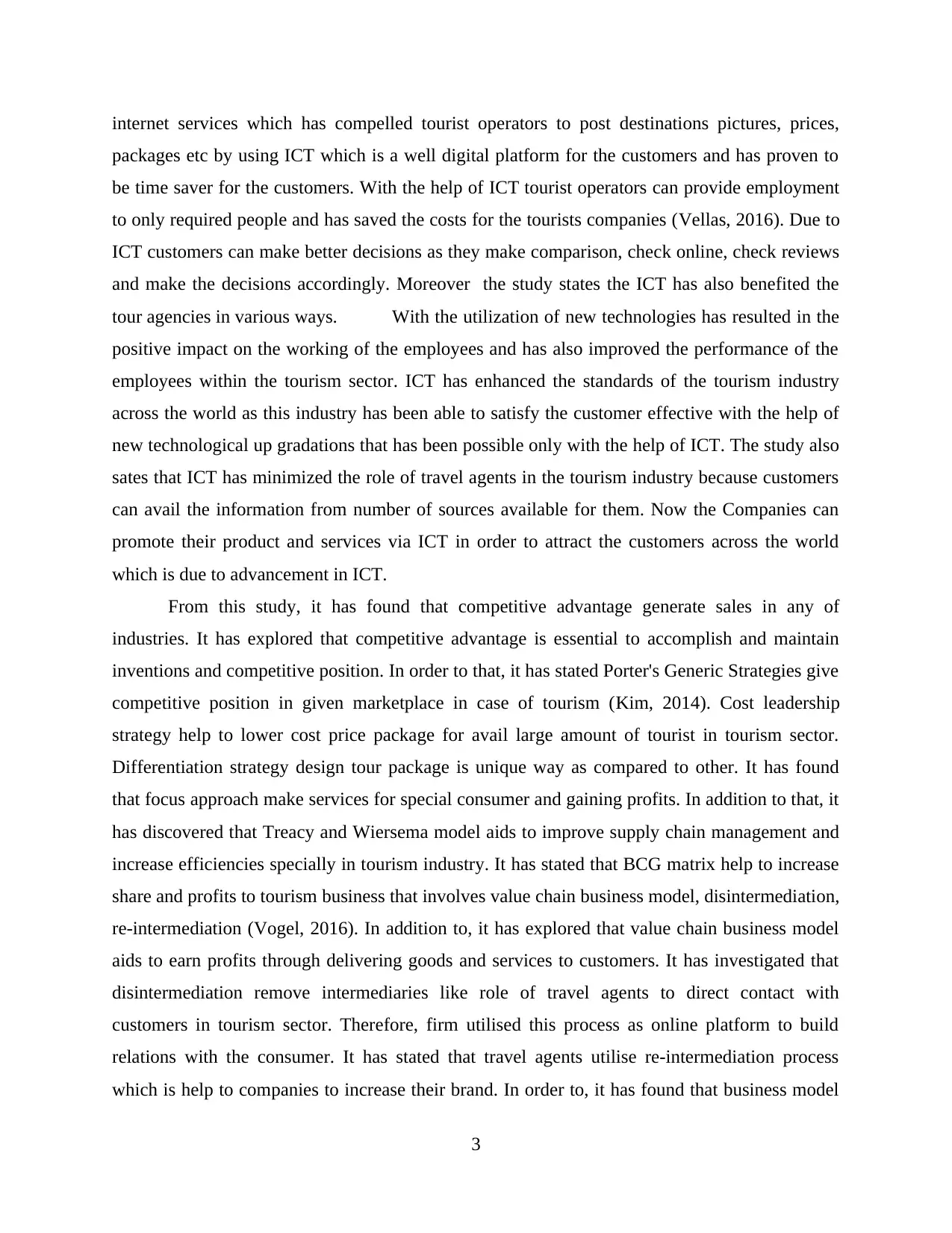
internet services which has compelled tourist operators to post destinations pictures, prices,
packages etc by using ICT which is a well digital platform for the customers and has proven to
be time saver for the customers. With the help of ICT tourist operators can provide employment
to only required people and has saved the costs for the tourists companies (Vellas, 2016). Due to
ICT customers can make better decisions as they make comparison, check online, check reviews
and make the decisions accordingly. Moreover the study states the ICT has also benefited the
tour agencies in various ways. With the utilization of new technologies has resulted in the
positive impact on the working of the employees and has also improved the performance of the
employees within the tourism sector. ICT has enhanced the standards of the tourism industry
across the world as this industry has been able to satisfy the customer effective with the help of
new technological up gradations that has been possible only with the help of ICT. The study also
sates that ICT has minimized the role of travel agents in the tourism industry because customers
can avail the information from number of sources available for them. Now the Companies can
promote their product and services via ICT in order to attract the customers across the world
which is due to advancement in ICT.
From this study, it has found that competitive advantage generate sales in any of
industries. It has explored that competitive advantage is essential to accomplish and maintain
inventions and competitive position. In order to that, it has stated Porter's Generic Strategies give
competitive position in given marketplace in case of tourism (Kim, 2014). Cost leadership
strategy help to lower cost price package for avail large amount of tourist in tourism sector.
Differentiation strategy design tour package is unique way as compared to other. It has found
that focus approach make services for special consumer and gaining profits. In addition to that, it
has discovered that Treacy and Wiersema model aids to improve supply chain management and
increase efficiencies specially in tourism industry. It has stated that BCG matrix help to increase
share and profits to tourism business that involves value chain business model, disintermediation,
re-intermediation (Vogel, 2016). In addition to, it has explored that value chain business model
aids to earn profits through delivering goods and services to customers. It has investigated that
disintermediation remove intermediaries like role of travel agents to direct contact with
customers in tourism sector. Therefore, firm utilised this process as online platform to build
relations with the consumer. It has stated that travel agents utilise re-intermediation process
which is help to companies to increase their brand. In order to, it has found that business model
3
packages etc by using ICT which is a well digital platform for the customers and has proven to
be time saver for the customers. With the help of ICT tourist operators can provide employment
to only required people and has saved the costs for the tourists companies (Vellas, 2016). Due to
ICT customers can make better decisions as they make comparison, check online, check reviews
and make the decisions accordingly. Moreover the study states the ICT has also benefited the
tour agencies in various ways. With the utilization of new technologies has resulted in the
positive impact on the working of the employees and has also improved the performance of the
employees within the tourism sector. ICT has enhanced the standards of the tourism industry
across the world as this industry has been able to satisfy the customer effective with the help of
new technological up gradations that has been possible only with the help of ICT. The study also
sates that ICT has minimized the role of travel agents in the tourism industry because customers
can avail the information from number of sources available for them. Now the Companies can
promote their product and services via ICT in order to attract the customers across the world
which is due to advancement in ICT.
From this study, it has found that competitive advantage generate sales in any of
industries. It has explored that competitive advantage is essential to accomplish and maintain
inventions and competitive position. In order to that, it has stated Porter's Generic Strategies give
competitive position in given marketplace in case of tourism (Kim, 2014). Cost leadership
strategy help to lower cost price package for avail large amount of tourist in tourism sector.
Differentiation strategy design tour package is unique way as compared to other. It has found
that focus approach make services for special consumer and gaining profits. In addition to that, it
has discovered that Treacy and Wiersema model aids to improve supply chain management and
increase efficiencies specially in tourism industry. It has stated that BCG matrix help to increase
share and profits to tourism business that involves value chain business model, disintermediation,
re-intermediation (Vogel, 2016). In addition to, it has explored that value chain business model
aids to earn profits through delivering goods and services to customers. It has investigated that
disintermediation remove intermediaries like role of travel agents to direct contact with
customers in tourism sector. Therefore, firm utilised this process as online platform to build
relations with the consumer. It has stated that travel agents utilise re-intermediation process
which is help to companies to increase their brand. In order to, it has found that business model
3
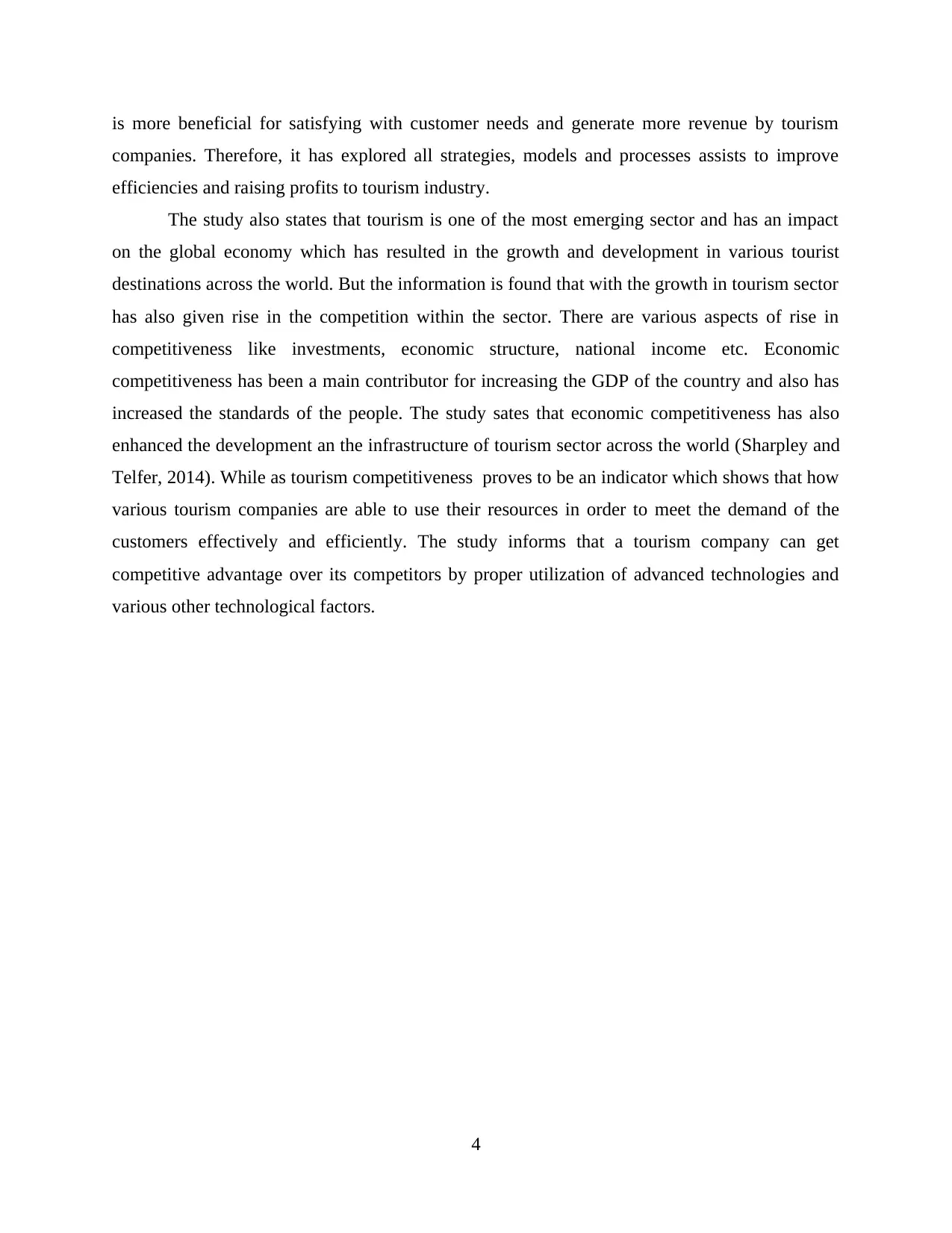
is more beneficial for satisfying with customer needs and generate more revenue by tourism
companies. Therefore, it has explored all strategies, models and processes assists to improve
efficiencies and raising profits to tourism industry.
The study also states that tourism is one of the most emerging sector and has an impact
on the global economy which has resulted in the growth and development in various tourist
destinations across the world. But the information is found that with the growth in tourism sector
has also given rise in the competition within the sector. There are various aspects of rise in
competitiveness like investments, economic structure, national income etc. Economic
competitiveness has been a main contributor for increasing the GDP of the country and also has
increased the standards of the people. The study sates that economic competitiveness has also
enhanced the development an the infrastructure of tourism sector across the world (Sharpley and
Telfer, 2014). While as tourism competitiveness proves to be an indicator which shows that how
various tourism companies are able to use their resources in order to meet the demand of the
customers effectively and efficiently. The study informs that a tourism company can get
competitive advantage over its competitors by proper utilization of advanced technologies and
various other technological factors.
4
companies. Therefore, it has explored all strategies, models and processes assists to improve
efficiencies and raising profits to tourism industry.
The study also states that tourism is one of the most emerging sector and has an impact
on the global economy which has resulted in the growth and development in various tourist
destinations across the world. But the information is found that with the growth in tourism sector
has also given rise in the competition within the sector. There are various aspects of rise in
competitiveness like investments, economic structure, national income etc. Economic
competitiveness has been a main contributor for increasing the GDP of the country and also has
increased the standards of the people. The study sates that economic competitiveness has also
enhanced the development an the infrastructure of tourism sector across the world (Sharpley and
Telfer, 2014). While as tourism competitiveness proves to be an indicator which shows that how
various tourism companies are able to use their resources in order to meet the demand of the
customers effectively and efficiently. The study informs that a tourism company can get
competitive advantage over its competitors by proper utilization of advanced technologies and
various other technological factors.
4
⊘ This is a preview!⊘
Do you want full access?
Subscribe today to unlock all pages.

Trusted by 1+ million students worldwide
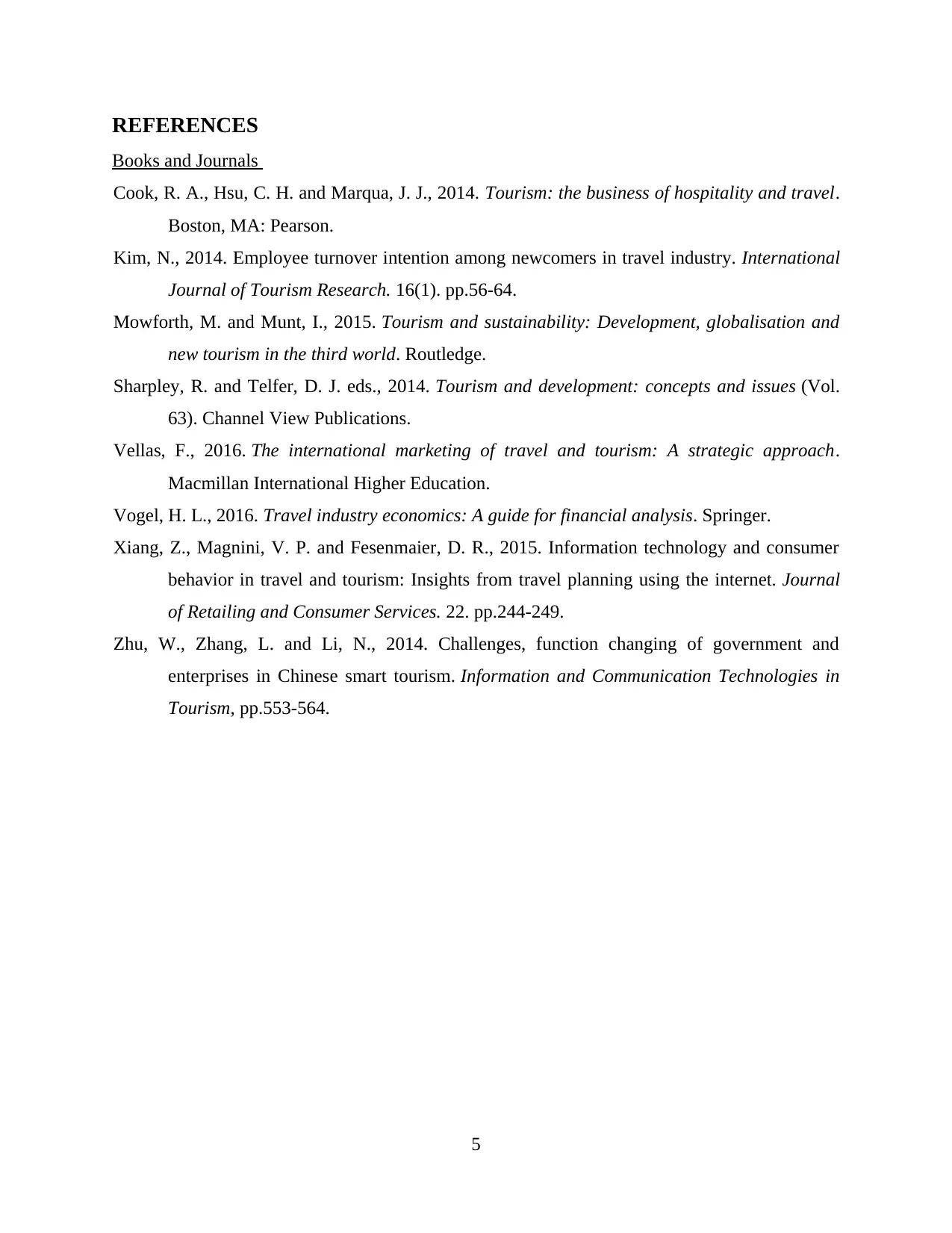
REFERENCES
Books and Journals
Cook, R. A., Hsu, C. H. and Marqua, J. J., 2014. Tourism: the business of hospitality and travel.
Boston, MA: Pearson.
Kim, N., 2014. Employee turnover intention among newcomers in travel industry. International
Journal of Tourism Research. 16(1). pp.56-64.
Mowforth, M. and Munt, I., 2015. Tourism and sustainability: Development, globalisation and
new tourism in the third world. Routledge.
Sharpley, R. and Telfer, D. J. eds., 2014. Tourism and development: concepts and issues (Vol.
63). Channel View Publications.
Vellas, F., 2016. The international marketing of travel and tourism: A strategic approach.
Macmillan International Higher Education.
Vogel, H. L., 2016. Travel industry economics: A guide for financial analysis. Springer.
Xiang, Z., Magnini, V. P. and Fesenmaier, D. R., 2015. Information technology and consumer
behavior in travel and tourism: Insights from travel planning using the internet. Journal
of Retailing and Consumer Services. 22. pp.244-249.
Zhu, W., Zhang, L. and Li, N., 2014. Challenges, function changing of government and
enterprises in Chinese smart tourism. Information and Communication Technologies in
Tourism, pp.553-564.
5
Books and Journals
Cook, R. A., Hsu, C. H. and Marqua, J. J., 2014. Tourism: the business of hospitality and travel.
Boston, MA: Pearson.
Kim, N., 2014. Employee turnover intention among newcomers in travel industry. International
Journal of Tourism Research. 16(1). pp.56-64.
Mowforth, M. and Munt, I., 2015. Tourism and sustainability: Development, globalisation and
new tourism in the third world. Routledge.
Sharpley, R. and Telfer, D. J. eds., 2014. Tourism and development: concepts and issues (Vol.
63). Channel View Publications.
Vellas, F., 2016. The international marketing of travel and tourism: A strategic approach.
Macmillan International Higher Education.
Vogel, H. L., 2016. Travel industry economics: A guide for financial analysis. Springer.
Xiang, Z., Magnini, V. P. and Fesenmaier, D. R., 2015. Information technology and consumer
behavior in travel and tourism: Insights from travel planning using the internet. Journal
of Retailing and Consumer Services. 22. pp.244-249.
Zhu, W., Zhang, L. and Li, N., 2014. Challenges, function changing of government and
enterprises in Chinese smart tourism. Information and Communication Technologies in
Tourism, pp.553-564.
5
1 out of 7
Related Documents
Your All-in-One AI-Powered Toolkit for Academic Success.
+13062052269
info@desklib.com
Available 24*7 on WhatsApp / Email
![[object Object]](/_next/static/media/star-bottom.7253800d.svg)
Unlock your academic potential
Copyright © 2020–2025 A2Z Services. All Rights Reserved. Developed and managed by ZUCOL.





